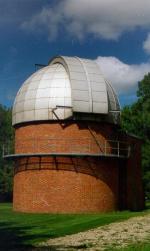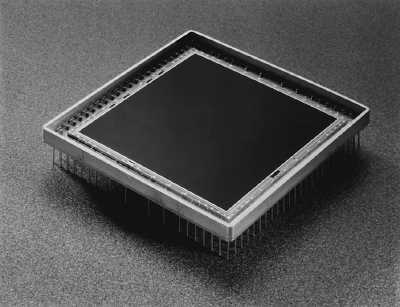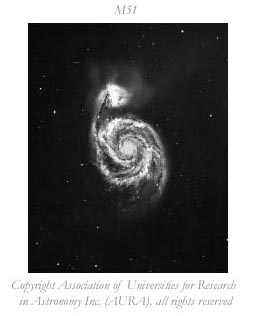| Warner and Swasey Observatory |
| Case Western Reserve University | Nassau Station |
| Visitors |
|
» Home » News » Gallery » Reference » Weather |
| Science Resources |
|
» NSRT User Interface » Software » Data Archive » Download Data |

|
 |
CCDs

Charge coupled devices, or CCDs, are an ever improving technology which allow astronomers to take high quality, short exposure, digital images. Instead of using regular photographic film, CCDs provide many assorted possibilities that would otherwise be difficult or impossible. In order to get good images, however, it is important that the equipment and the viewing object are correctly matched. As many opportunities as CCDs provide, it is also easy to get a very ugly or fuzzy image if care is not taken to make sure that the different pieces are working together correctly.
A CCD works by converting light (photons) into electrical charges (electrons). The way that this process works is that when a photon which has a high enough energy (in the visible or infrared range) hits the silicon, it excites an electron into a higher energy level, and an electron (negative)-hole (positive) pair are created. Charge is then collected on the individual pixels, and transfered along vertical and horizontal registers due to the differential voltage that is applied. These charges are then digitized and encoded. The time that this process takes depends on the system throughput, and the quality of the image depends on the sampling . Since one electron comes from each single photon, the light of the photons can be easily understood as being the number of electrons on each pixel.

Quantum Efficiency (QE) - the response of the sensor to light of different wavelengths. Silicon CCDs are most sensitive in the infrared region, but they can be coated with special substances in order to become sensitive to ultraviolet light.
Charge Transfer Mechanism - photons fall on the surface of the CCD, and electrons accumulate on each pixel. The well depth is defined as the number of electrons per pixel. The well depth is 85,000 for the Nassau Station telescope. After the exposure takes place (the shutter is now closed), the charges are transferred first along vertical columns to the horizontal register, and then horizontally to the output amplifier.
On-Chip Pixel Binning - "Super pixels" can be made if the CCD has the capability of clocking several pixels into larger pixels of similar dimensions. A 2 by 2 super pixel is made up of 4 individual pixels, and has the area of these four pixels, as well as their charge. This new larger pixel has a light sensitivity that is four times higher than a single pixel, but only half the resolution. An important consideration before choosing to bin, are the capabilities of your A/D (analog to digital) converter. If the converter can only process a single pixel's worth of electrons, then binning should not be used.
System Gain - the number of electrons that are represented by each count. For something that has a gain of 2 ADU (analog to digital units), for example, (42,500 counts)*2 ADU = 85,000 electrons. The system gain is a balance between the digitization counts, digitization noise, and well depth. Generally a lower gain is better so that the digitization noise level is low, but it should not be too low so that the noise minimization does not come at the expense of the well depth.
Noise Sources - Noise is the random fluctuations that add unwanted signals to your data. There is no perfect reproducability, and no perfect equipment, so it is always important to remember to take into account the uncertainties and errors that noise can bring into any data. The lower the noise, the greater your ability to differentiate a signal from a noisy background, even under poor conditions of light.
 Photon noise - the natural variation of incident photon flux. This kind of noise has a value of about the square root of the signal
Photon noise - the natural variation of incident photon flux. This kind of noise has a value of about the square root of the signal  Read noise - the uncertainty during the quantifying of the electronic signal on the CCD; the majority of this noise comes from the on-chip preamplifier
Read noise - the uncertainty during the quantifying of the electronic signal on the CCD; the majority of this noise comes from the on-chip preamplifier  Dark noise - statistically varying quantities of thermal electons that are generated within the layers of silicon; this noise can be reduced by cooling the CCD but can not just be subtracted out the way that the dark count often can be
Dark noise - statistically varying quantities of thermal electons that are generated within the layers of silicon; this noise can be reduced by cooling the CCD but can not just be subtracted out the way that the dark count often can be
Signal To Noise Ratio - the ratio of the signal to the noise that is present in that signal.
System Throughput - defined as 1/(total time/number of pixels), or the number of pixels/total time. Even if your computer is very fast, if the other equipment is slow, then the total time between the closing of the shutter, and the moment when the image can be seen is still long. The total time includes the transfer and digitization of charge, the transfer to the computer's memory, and the time it takes to display the image. The system throughput is important because the dark count continually increases during all of the time that passes.
Dynamic Range - Basically, the higher this is, the better. More technically, the dynamic range is the logarithm, base 10, of the well depth/readout noise, and it is in decibels (dB). This can be used to define the appropriate number of digitization levels for a sensor. For example, if the well depth is 150,000 electrons, and the readout noise is 10 electrons, then 150000/10 = 15000, so 14 bit digitization is appropriate (214 = 16384).
Charge Transfer Efficiency (CTE) - As charge is transferred along the registers, some electrons get trapped and do not move along with the rest. The CTE is a measure of how many electrons get left behind. For example, a CTE of 0.99999 means that for a well depth of 85,000 electrons, less than 1 gets trapped-- very efficient.

Sampling - a measure of the number of pixels used to produce the desired details. Images are composed of pixels whose brightness is assigned a shade of gray by whatever display routine is being used. The assumption is that the more pixels per object you have, the better the image. Actually, too many pixels for a single object is oversampling, and, while it can be useful for some objects, it also reduces the sensitivity of the individual pixels. A useful relationship to remember is
where µ is the pixel size in microns (10-6 m), and f is the focal length of the telescope in millimeters (10-3 m). Multiplying P by the number of pixels on each side of the CCD chip, and dividing by 60 (to convert to arcminutes) gives your field of view.
Other Useful Terms
Dark Count - the number of electrons that are generated thermally on the CCD and which contribute to the noise. This is measured in electrons/unit time for a given temperature. The dark count can often be subtracted out, but if it gets too high, then the error associated with this subtraction can get high. The dark noise is the square root of the dark count.
Oversampling - when there are too many pixels for the image of the object. This is often better when doing images of bright planets.
Pixels - made of electrodes, they are the individual squares that make up the digital image.
Pixel Sensitivity - the larger the pixel, the more sensitive the camera is at any focal length, but the lower the resolution.
Undersampling - when there are too few pixels for a given image. Undersampling is used when doing imaging of galaxies and nebulae.
For more technical information check out these sites: